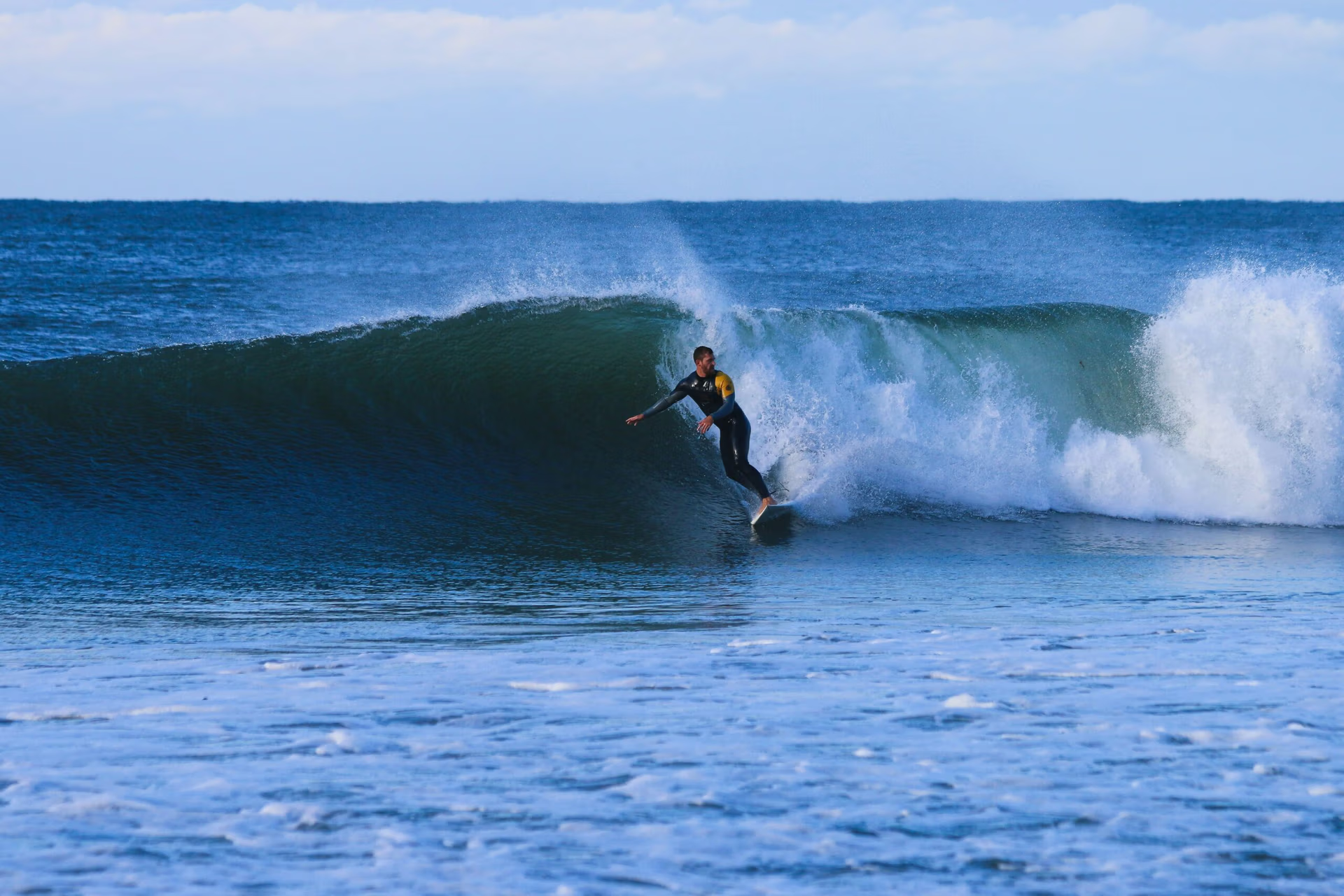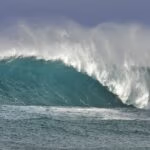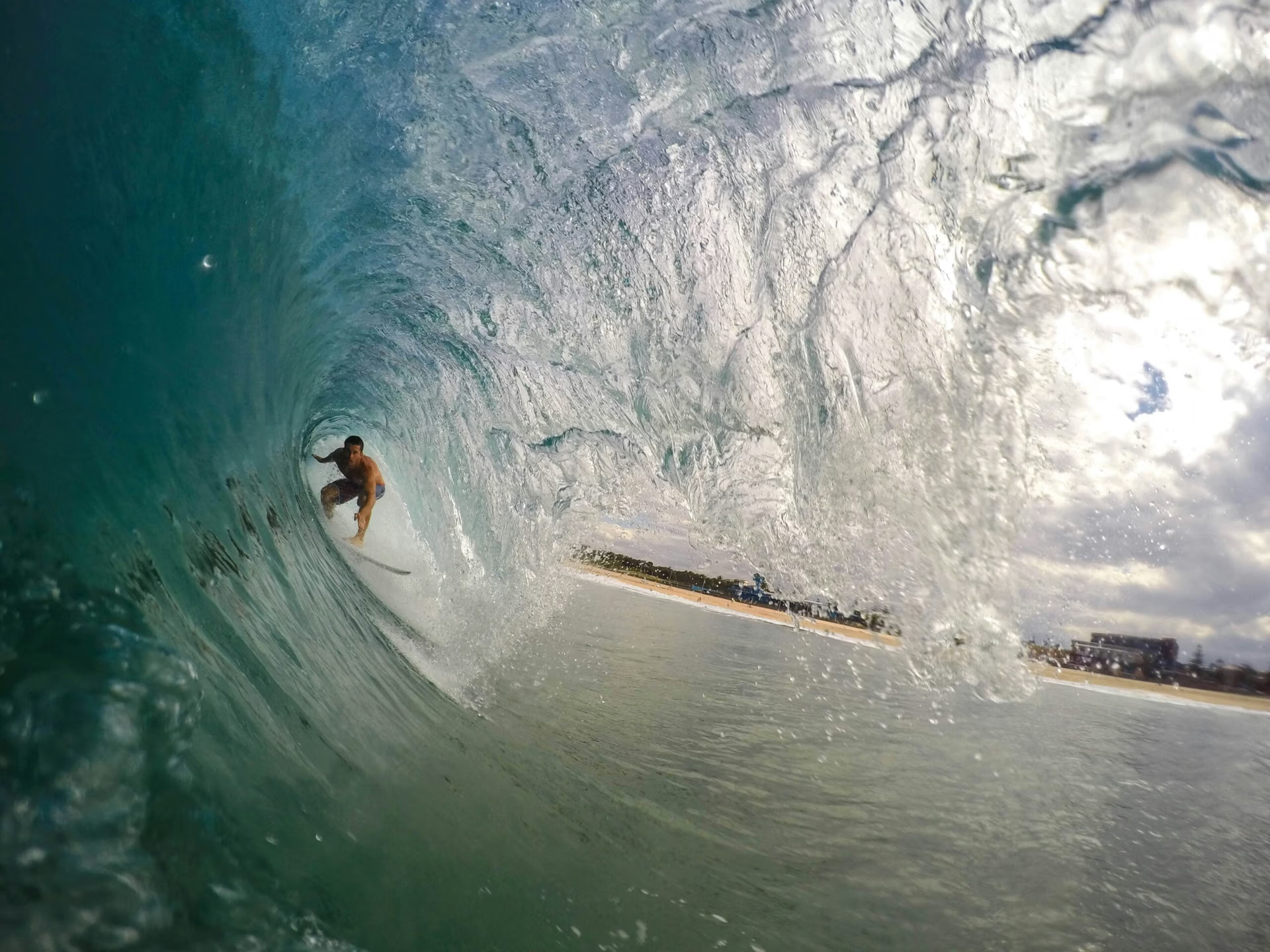Understanding Ocean Waves
Ocean waves play a significant role in the dynamics of the ocean environment and are essential for various water sports, particularly surfing. The foundational understanding of ocean waves begins with their formation, predominantly influenced by wind action. When the wind blows across the surface of the water, it transfers energy to the water, resulting in wave formation. The size and strength of waves depend on multiple factors, including wind speed, duration of the wind, and the distance over which the wind travels, commonly referred to as the “fetch.”
Additionally, ocean floor topography significantly impacts wave characteristics. When waves travel over varying elevations or depressions on the ocean floor, they can change in height, speed, and direction. For instance, when waves approach shallower water near coastlines, they slow down and increase in height, leading to the formation of breaking waves, which are particularly sought after by surfers. Coastal features such as reefs and sandbars also contribute to wave formation, creating unique surf conditions that can cater to different styles and skill levels of surfing.
Weather patterns, such as storms and ocean currents, also influence wave production. Storm systems can generate large swells that propagate over long distances, resulting in substantial waves upon reaching the shoreline. Conversely, calmer weather may produce smaller, more gentle waves ideal for beginners. Understanding these dynamics not only enriches one’s knowledge of ocean waves but also prepares surfers to anticipate conditions that define different types of surfing experiences.
Thus, the interplay between wind, ocean floor topography, and weather patterns creates a diverse array of wave types, each presenting unique challenges and opportunities for surfers. Gaining insight into these foundational elements of ocean waves is essential for anyone interested in the sport of surfing.



Beach Break Waves
Beach break waves are a popular type of surf wave known for their formation over sandy bottoms. Unlike reef breaks or point breaks, beach breaks are characterized by their unpredictable nature, which can vary significantly from one surf session to another. These waves form when swells from the ocean break onto sandy beaches, creating a dynamic surfing environment that can be both exciting and challenging for surfers of all levels.
The variability of beach break waves can be attributed to several factors, including tide levels, wind conditions, and the shape of the ocean floor. As the tide rises and falls, the waves can become steeper or flatter, leading to different types of rides. Furthermore, beach breaks can produce both left- and right-handed waves, depending on the direction of the swell and the slope of the beach. This variety can offer surfers a diverse experience, making each outing to the beach potentially unique.
For surfers looking to navigate beach breaks effectively, there are several practical tips to consider. Firstly, observing the surf conditions from the shore before entering the water is crucial. This allows surfers to identify where the waves are breaking consistently and helps determine the best spot to catch them. Additionally, understanding the tide is vital; certain breaks work better during high tide while others may only produce quality waves during low tide.
Moreover, surfers should be aware of their own skill levels and choose beach breaks that align with their experience. While beginners can enjoy the forgiving nature of softer waves found in smaller beach breaks, more experienced surfers may seek out larger, more powerful waves that require advanced techniques and greater awareness of the changing conditions. Overall, beach break waves provide an exciting surfing experience, characterized by their ever-changing nature, giving surfers a true taste of the ocean’s diverse personality.
Point Break Waves
Point break waves are a unique and highly sought-after type of surf wave that occurs along a point of land. These waves break in a consistent manner, allowing for longer rides that can be enjoyed by surfers of various skill levels. The formation of point breaks is typically influenced by the angle at which swells approach the shoreline, coupled with the underwater topography. When the waves reach a point, they refract and break, creating a long, peeling wave that consistently rolls toward the beach.
Ideal conditions for surfing point breaks are often characterized by certain factors, including swell size, wind direction, and tide. Generally, a medium to large swell is required to generate sufficient energy for surfable waves. Additionally, offshore winds—those that blow from the land out to sea—are preferred, as they help shape the waves and maintain their form. Surfers can expect the best surfing conditions at specific tides, with many point breaks favoring mid to high tide for optimal rideability.
Many renowned surf spots around the globe showcase exceptional point break waves. Locations such as the iconic Malibu in California offer a perfect example of a point break, where the waves mold into long, rideable segments, popularly known as “Malibu rights.” Another notable place is Jeffrey’s Bay in South Africa, recognized for its world-class right-hand point break that draws surfers from all over for its remarkable length and quality. The diversity found in point break locations, influenced by geography and climate, continues to attract surf enthusiasts eager to embrace the thrill of riding these magnificent waves.
Reef Break Waves
Reef break waves are a unique and thrilling type of surf condition that occurs when ocean swells pass over coral or rocky reefs, creating impressive breaks. These waves are often characterized by their powerful, fast, and steep nature, making them suitable for experienced surfers looking to challenge their skills. The distinct structure of a reef can significantly influence how waves behave; for instance, the shape and depth of the reef can create hollow waves that are ideal for barreling, providing surfers with advanced opportunities for maneuvers.
One of the key features of reef break waves is their tendency to break in specific spots, depending on the swell direction and tide. Surfers must be able to read the ocean’s conditions and understand where to position themselves for the best ride. Additionally, the sharpness of the coral or rock can pose serious hazards, necessitating heightened awareness and caution when surfing these types of waves. Successful navigation of reef breaks requires not only surfing skill but also knowledge of the particular reef’s characteristics, such as currents and shallows.
When attempting reef break surfing, proper gear is essential. A durable surfboard, preferably one designed for fast and responsive surfing, is recommended to handle the powerful waves and possible impacts with the reef. Surfboards with thicker rails can offer added buoyancy and stability. Furthermore, protective gear, such as a wetsuit with additional padding or reef booties, can help minimize injuries from potential scrapes or cuts on the reef.
Ultimately, while reef breaks can offer exhilarating experiences and stunning waves, surfers must prioritize safety and preparedness. Taking the time to educate oneself about the specific reef break conditions and suitable equipment ensures both a thrilling and secure surfing adventure.
River Waves
River Waves
River waves, distinct from ocean waves, are formed in fast-moving rivers and streams, offering a unique surfing experience. These waves arise due to a combination of the river’s current and geographical features, such as rocks or riverbed contours. The resulting standing waves provide surfers with a stationary swell that can be ridden indefinitely, depending on the water conditions and the surfer’s skill level.
One significant characteristic of river waves is their consistency. Unlike ocean waves, which are subject to the influences of tides, weather, and wind, river waves can be reliably surfed at certain times of the year or during particular conditions. Surfers often find themselves riding these waves in specific spots known as ‘river mouths’ or near obstacles in the water that create ideal wave shapes. However, despite their predictability, river waves can also be particularly challenging due to the strong currents and the fluctuating nature of river conditions.
For those interested in river surfing, specific techniques are essential to navigate these unique waters. Surfers often employ techniques such as pumping and carving to maintain speed and control on the wave. It is imperative for surfers to become adept at reading the river’s dynamics, understanding how to position themselves on the wave, and executing turns effectively to utilize the wave’s energy. River surfing gear also differs from traditional surfing equipment. Surfers typically opt for specialized boards, often shorter and thicker, designed to handle the more aggressive freshwater environment.
Finally, environmental considerations are vital when engaging in river surfing. It is crucial to be aware of water quality, wildlife, and other natural factors that could impact not only the surfing experience but also the ecosystem. By remaining conscious of these elements while respecting the natural environment, surfers can enjoy river waves sustainably and safely.
Wind Waves
Wind waves are formed when the wind blows across the surface of the water, transferring its energy to create a range of wave types characterized by varying heights and frequencies. The conditions under which wind waves develop can significantly impact surfing experiences. Factors such as wind speed, direction, and duration play crucial roles in determining the size and frequency of the resulting waves. As surfers, understanding these elements is essential for effectively riding these dynamic waters.
The strength of the wind acts as a primary factor that influences wave formation. Generally, stronger winds generate larger waves, while gentler breezes produce smaller ones. Wind waves are particularly noticeable when sustained winds blow for longer periods, as this allows the transfer of energy to build up larger surfable waves. Surfing enthusiasts often check local wind conditions to forecast wave quality, as even a brief period of strong wind can have a considerable effect on developing and shaping waves.
Besides the strength, the direction of the wind also determines wave characteristics. Onshore winds can create choppy conditions, making it more challenging to ride waves smoothly. Conversely, offshore winds tend to groom the waves, promoting cleaner faces that are more desirable for surfing. For optimal riding conditions, surfers often seek out spots protected from onshore winds while being positioned for favorable offshore breezes.
Surfers can adopt specific strategies to effectively ride wind waves by recognizing how different wind conditions impact their chosen surf spots. Properly gauging wind strength and direction before hitting the water can make a significant difference. Additionally, understanding local geographical features, such as reefs or sandbars, may further enhance a surfer’s ability to ride these waves successfully.
Tide Pools and Their Effects on Wave Formation
Tide pools are shallow, rocky areas created by the ebb and flow of ocean tides. They play a crucial role in shaping the characteristics of surfing waves, primarily influenced by the varying tide levels. Understanding the connection between tide pools and wave formation can significantly enhance a surfer’s experience by providing insights into optimal surfing conditions.
The relationship between tides and surf quality stems from the changes in water depth and the structure of the ocean floor as tides rise and fall. During high tide, waves may break differently compared to low tide due to the increased water covering the ocean floor. High tide generally results in fewer exposed rocks and shallower reef areas, often producing softer and mellower waves, which can be ideal for beginners. Conversely, low tide usually unveils more of the ocean floor, exposing reef formations or sandbars that can create steeper, more powerful waves preferred by experienced surfers.
Additionally, surfers should consider the timing of tide changes when planning a session. Each surf spot can react uniquely to the tides; for instance, some beaches may have a specific tide range that yields the best surfable conditions. Therefore, it is advisable for surfers to research local tide charts and historical data to ascertain when the waves are at their best. Being aware of the tide can also help surfers understand the potential for riptides and currents, which are often more pronounced during certain tidal periods.
In conclusion, tide pools significantly affect wave formation and surfing conditions. By understanding the impacts of high and low tides, surfers can better plan their sessions and enhance their overall surfing experience, ensuring they catch the best waves available.
Conclusion
Choosing the right type of wave is essential for surfers at any skill level, as it directly impacts both the enjoyment and safety of the surfing experience. Initially, beginner surfers should focus on soft, small, and consistent waves, typically found at beach breaks. These waves provide a more forgiving environment, allowing novice surfers to practice paddling, balancing, and riding without the intimidation of larger, more powerful surf. Identifying local surf spots with gentle waves is crucial to gaining confidence and skills.
As surfers progress, transitioning to smaller point breaks with a bit more punch can offer an exciting challenge. These waves generally have a more identifiable take-off point and allow surfers to practice turning and controlling speed. However, it is imperative to ensure that the surf conditions are still manageable to avoid overwhelming oneself. Understanding the dynamics of the ocean is vital, as even seemingly innocuous changes in a wave’s size or shape can significantly affect rideability.
For intermediate surfers looking to advance their skills, manageable reef breaks can provide diverse wave types that offer steeper faces and faster rides. Care must be taken when navigating these areas, as the presence of coral or rocks can pose hazards. Studying the characteristics of waves at various breaks, as well as understanding tidal patterns can empower surfers to choose appropriate locations based on their abilities.
Ultimately, one should never lose sight of the objective—having fun and enjoying the surf. With consistent practice and mindful progression through different wave types, surfers can confidently enhance their skills while prioritizing safety. Selecting suitable waves aligned with one’s experience stimulates growth in both technique and passion for the sport.
Resources for Further Learning
For those interested in deepening their knowledge about different types of surfing waves, a wide range of resources can be found across various platforms. Books dedicated to surfing, such as “The Complete Guide to Surfing” by David McCauley, offer comprehensive insights into wave types, techniques, and surf culture. Another notable recommendation would be “Surf’s Up: The Essential Guide to Surfing” which breaks down wave conditions and provides practical advice for surfers of every skill level.
In the digital age, numerous websites serve as valuable educational tools for surfers. Websites like Surfline and Magicseaweed not only provide surf forecasts but also feature articles and blogs on wave formation and characteristics. These platforms compile information from surfers globally, making them essential for understanding local conditions and gaining insights into different surfing spots.
Documentaries can also enhance your surfing knowledge and appreciation. Films such as “Riding Giants” and “Step into Liquid” showcase legendary surfing waves and the stories of those who ride them, enriching your understanding of the culture surrounding the sport. Streaming platforms frequently feature documentaries that explore the science and art of surfing waves, providing both entertainment and education.
Joining surfing forums or community groups can further augment your learning experience. Websites like Surfer Today and the Surfing subreddit on Reddit offer spaces for novice and experienced surfers to connect, share knowledge, and discuss their personal experiences. Engaging with these communities promotes ongoing learning, allowing surfers to continuously improve their skills and deepen their connection to the sport.
These resources collectively foster an enriching environment for anyone eager to explore the fascinating world of surfing waves and enhance their surfing journey through shared knowledge and communal support.